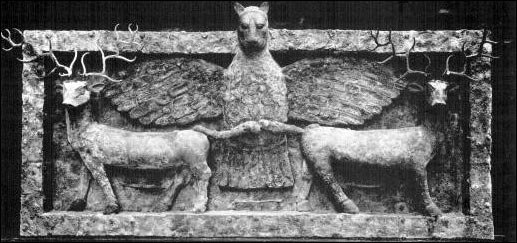Date
ca. 2500 B.C.
Origin
The Ancient World : The Middle East : Pre-Sargonid Period
Description
a,b) Monumental relief showing lion-headed eagle Imdugud, grasping hind-quarters
of pair of stags standing back-to-back beneath its outstretched wings.
This monumetal copper relief was discovered, along with numerous other
objects, at the foot of a high terrace which once supported a temple
dedicated to the goddess Ninhursag and built by one of the kings of
Ur at the neighboring site of al 'Ubaid. (For a discussion of this temple,
see 2Bd.002.) The excavator, Sir Leonard Woolley, reconstructed the
badly damaged plaque as showing the lion-headed eagle Imdugud (the head
of the bird had vanished completely), and suggested that it had once
been placed over the temple doorway. However, the presence of three
handles on the lower portion of the relief suggests that it may have
been attached to a moveable piece of temple furniture, such as a large
chest, or may have been brought out of the temple for viewing only during
certain religious rites or festivals.
The lion-headed eagle Imdugud, whose outspread wings were the black
rain cloud and whose roar was the rumbling thunder, was the symbol of
the storm god Ningirsu, the 'Lord of Girsu'. As the power in the rains
which bring to life the greenery of spring upon the Mesopotamian plains,
Ningirsu was the protector of animals, born wild and domesticated, and
was thus customarily represented grasping a symmetrically placed pair
of his charges by their hind-quarters (see also 2Bd.021, . 094).
Ningirsu was the Lagash form of Ninurta, the god of thunder, rainstorms,
and floods of spring - and thus also of the spring ploughing - and son
of the goddess Ninhursag. In the epic Lugal-e (which Kramer refers to
as "The Destruction of Kur"), Ninurta is alerted by his weapon,
Sharur, that a being called Asag, who dwells in the mountains, threatens
the land. Ninurta journeys to the strange land, vanquishes his opponent,
heaps up great piles of stones, and brings increased abundance to the
country. Hearing of her son's heroic deeds, his mother Ninhursag is
overcome by pride and rushes to him; he, in gratitude for her devotion,
names the heaps of stones Hursag ('mountain') and appoints her its queen.
Jacobsen, in a review of Kramer's book (both cited below), suggests
that Asag, whose name means 'The Cripple', represents the freezing cold
of winter, pitted against Ninurta, the forces of spring. 'Their battle,
which takes place over the mountains, can be heard in the roar of the
thunderstorms which herald the Mesopotamian spring. Before Asag was
vanquished, the Subterranean waters used to go up into the far mountains,
where they froze, but Ninurta built the hursag, the near ranges, to
prevent the waters from so doing and led them into the Tigris. This
seems to have reference to that melting of snows on the high mountains
in spring which causes the yearly flood. Altogether the myth of Ninurta
and Asag appears to be a nature myth telling of the yearly battle of
spring and winter."
Thus a relief depicting an aspect of the god Ninurta finds an important
place in the temple of Ninhursag, where it nay have formed part of a
spring ritual celebrating the renewal of life through the powers of
the 'Lady Birth-giver' and her heroic son.
Object
Relief (copper; ht. 3', 6 1/8", w. 7' 10").
Style or School
Mesopotamian. Early Dynastic III.
Material or Technique
Metal (restored).
Provenance
Found in the temple of Ninhursag at al Ubaid.
Repository or Site
London: Mus., British; No. 114308.
Image Sources
a) from Garbini.* [JF 1211]
b) from Giedion.** [JF 2230]
References
*Garbini, G., Ancient World (1968), p.50; pl.22.
**Giedion, S., ...Architecture (1964), P.56; fig.19.
Kramer, S.N., Sumerian (1961), pp.79-82.
Jacobsen, T., Tammuz (1970), pp.30,32-33,121-125.
Strommenger, E., Mesopotamia (n.d.), pp.398-399; pl.79.
Woolley, C.L., Art (1961), pp.47-61; pl.p.57.
Woolley, C.L., Development (1935), P.73; pl.28b.
Levy, G.R., Gate (1948), p.101.
Parrot, A., Sumer (1961), pp.158-159; pl.187. |

